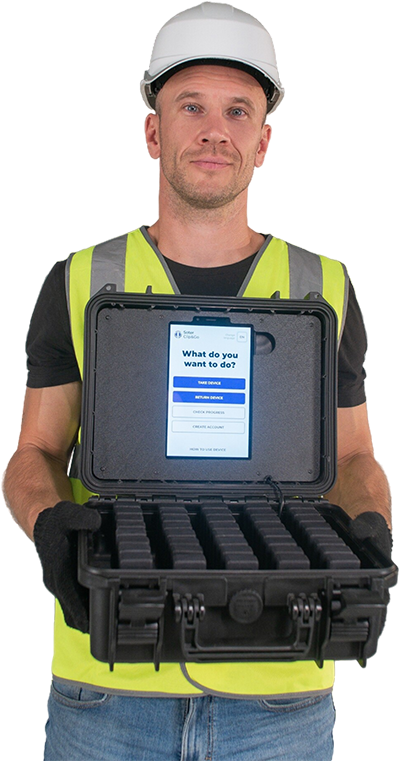Wearables for Safety – Worker Acceptance, Union Buy-in & Data Security Measures
The broad adoption of wearables in the workplace is largely dependent on overcoming certain barriers. A study published in the Journal of the Human Factors and Ergonomics Society notes that these barriers include worker acceptance and privacy/confidentiality of data.

The broad adoption of wearables in the workplace is largely dependent on overcoming certain barriers. A study published in the Journal of the Human Factors and Ergonomics Society notes that these barriers include worker acceptance and privacy/confidentiality of data (1). When it comes to deciding to take on any form of safety technology, being equipped with the right arguments around worker acceptance, having extensive knowledge of what is being collected, deciding on what is most important to be collected and having up to date information ready to deal with any union acceptance setbacks is paramount.
Worker acceptance
Union buy-in
Data security measures
Worker Acceptance
The Journal of Human Factors and Ergonomics Society published a study in 2018 showing that approximately eighty percent of health and safety professionals would consider using wearable technology to help track and monitor risk factors at work (1). Workers acceptance on the other hand is paramount to whether the technology achieves its goals to keep people safe. The study showed the following worker concerns around acceptance (1):
Privacy/confidentiality of collected data
Employee compliance – workers concerned with not being able to follow and use as per organizational guidelines
Sensor durability – in some industries such as construction and manufacturing
Safety of the devices – in industries such as oil, energy and gas
Taking the above into consideration – when implementing any safety technology, it is important to:
Know the product well prior to approaching the employees and prepare workers mentally
Provide past successes of the device/program particularly in related industries
Prove the suitability of the wearable to the organization
Show case the benefits and what it will mean for the individuals
Ensure the quality and reliability of the technology
Involve the workers in the decision process by addressing all concerns and aversions around deployment
Encourage open non-judgmental communication around acceptance and implementation
Stimulate discussion amongst the employees prior to presenting the technology
Diminish any fear by being educated in the subject of data security and privacy and communicate this clearly and openly to workers
Provide proof that data security measures have been implemented and that research in terms of credibility on the provider has been conducted
Openly discuss the data collection, how it is being used and whether it will be aggregated or anonymised rather than individualised
Clearly set out exactly what data is being collected and why
Keep data recording only during working hours
Employee compliance issues
Provide workers with clearly set out instruction sheets
Keep the implementation process simple and quick
Appoint a ‘champion’ or worker that can help anyone having technical issues
The way in which technology is presented to employees makes a significant difference to the adoption and as to whether safety goals and benefits are achieved.
Union Buy-in
Worker productivity has been measured for quite some time. It dates back to the 1900’s with well-known industrialists Frederick W Taylor and Frank and Lillian Gilbreth and their concept of studying the work being completed to bring about changes and improvements to work processes. Their scientific management theory had an underlying promise of increased productivity and is still used in businesses today, systems such as organizational charts, performance management and production goals. The modern version of their work is sometimes referred to now as Digital Taylorism whereby it is said that machines can provide the scientific management of the workers. It is easy to note that Taylor and Gilbreth and the changes they brought to businesses suggest that they were not the workers ‘friend’ but it is clear that their methods have greatly impacted the business world today (6).
With this in mind, it is understandable now with advances in safety technology that unions are sceptical about the ‘suggested’ use of these products. First main concern is generally in relation to the devices possibly being used for ‘spying’ on the workers in terms of performance, for example, geolocation data, and organisations having the data ‘proof’ to use against the employees. Second is the issue with data collection security and privacy – which has been explained above.
It is simply a balance – do the benefits of the technology outweigh the risks associated?
Ways to gain union buy in are:
Know the product well before approaching and communicate openly and clearly about the benefits, proving that the technology is not aimed at providing new methods for Digital Taylorism or performance management, but the focus is purely on safety and safety management
Involve the union in the decision-making process and be receptive to any concerns
Be aware of and find out exactly what data is being collected by the safety technology provider and make sure that only relevant data is collected
Work with the technology provider to come up with ways to mitigate some of the risks as much as possible for example:
Disengage GPS (geolocation) if employee location is not absolutely necessary
Allow only aggregated and/or anonymised data to be available to management
Allow workers to see all their own data and have access to it regularly
As industry 4.0 and laws around this are continually evolving, it is important to involve everyone in the organisation in the discussion when deciding to deploy any safety technology – H&S teams, HR, legal, innovation teams, operational management. Once these discussions have been had, involve the workers in the decision and seek feedback. This will allow for all possible setbacks, from data collection issues to worker acceptance to be put forward before engaging and help with covering any gaps or worker concerns missed by management.
Data Security Measures
Eric Schmidt, former Google CEO, in 2010 commented, ‘Mankind generates as much information now in two days as it did from the dawn of civilization up to the year 2003’(2)
There is always a slight fear when using any kind of smart technology in relation to its ability to be able to collect data and vendors having the opportunity to share it for commercial or other purposes. Certain products do have a significantly higher risk around hacking threats, like identity theft, than others however it is noted that devices used for safety are generally deemed a fairly low risk (3). Reason being is they usually don’t store any financial details or passwords that would be required for any kind of identity theft. They may hold movement and biometric data and while the user would not like this information revealed, the safety threat in terms of identity theft of financial threat is less. There are issues on the other hand around hacking especially for safety devices when it comes to its performance, for example, a hacker can disable any of the functions of the technology which may end in an unfavourable way.
When engaging any third-party service or purchasing any product in general, it’s important to do research on the company. In terms of data security, it works the same way. If some areas fall outside of the OHS professionals’ scope, then talking to inhouse IT specialists or simply asking for proof or information based on the following is not unreasonable:
Make sure the product has been designed and manufactured by engineers and not by a traditional consumer-goods producer
Question and ask for detailed proof that the engineers are trained in data security and have addressed the security concerns with the principle of ‘reasonable security’ in terms of the technical, physical and administrative requirements
Check that encryption measures have been included so that they are less vulnerable to hacking
Be mindful of unsophisticated devices that do not necessarily have the space to add the processing power required by security measures and can sometimes lack robust data security
Check and make sure there is possibility of regular updates and that they are conducted to ensure the security of any possible threats
Ask for a copy of the vendors Data Privacy Policy. It is worthwhile checking if they have clear information available that covers their legal obligations, explains exactly what the company deems as ‘personal information’, how they secure it and that it is written in layman’s terms, so it is possible to distribute to workers and unions
If using the product in Europe, make sure the company is GDPR compliant. The legislation came into force across the European Union in May 2018 (4). GDPR stands for The General Data Protection Regulation and was brought about to protect consumers and organisations collecting data must do so under strict legal conditions. Data is anything that can be processed to uniquely identify an individual, from name, address, photos, genetic or biometric data.
If the product is from the US, there is no federal data privacy law so check with the company as to what state laws they have adhered to and what their definition of ‘personal data’ is as this differs between the states. Each state has its own form of data security measures they must follow. California is known to have one of the broadest laws, in 2018 they enacted what is called the California Consumer Privacy Act (CCPA) and it became compulsory in January 2020.
Conclusion
When adopting any new technology or system into organisations first gain proof to help with acceptance. Review industry specific case studies, past successes, ensure quality and reliability of the technology and then most importantly suitability. Use clear and open communication to unions and users and make sure the benefits that the wearable tech provides can easily break through the barriers involved. Executing proper assessment of using wearables by involving all stakeholders in the decision making helps to eliminate fear and sets up for positive outcomes.
Originally published at ASSP on August, 2020.
About Soter Analytics
Soter Analytics is a global safety science company producing AI-supported wearable solutions that reduce the risk of ergonomic injuries in the workplace. Soter wearables are widely used in logistics, manufacturing, healthcare and other industries, helping leading companies to prevent up to 55% of back & shoulder musculoskeletal injuries.
To see how Soter Analytics can help you improve safety behaviour, engage employees to self-manage their training and prevent workplace ergonomic injuries, simply Book a FREE Demo today.
References
Schall, M., Sesek, R., & Cavuoto, L.(2018). Barriers to the Adoption of Wearable Sensors in the Workplace: A Survey of Occupational Safety and Health Professionals. Human Factors: The Journal of Human Factors and Ergonomics Society, 60(3), 351–362. https://doi.org/10.1177/0018720817753907
Siegler, M.G. (2010) Eric Schmidt: Every 2 Days We Create AS Much Information As We Did Up to 2003. TechCrunch. Retrieved from: https://techcrunch.com/2010/08/04/schmidt-data/
Shahmiri, Sara. “Wearing Your Data on Your Sleeves: Wearables, the FTC, and the Privacy Implications of This New Technology.” Texas Review of Entertainment and Sports Law 18.1 (2016): 25–. Print.
GDPR.EU. What is GDPR, the EU’s New Data Protection Law? Retrieved from: https://gdpr.eu/what-is-gdpr/
State of California Department of Justice (2019) CCPS Fact Sheet. Retrieved from https://oag.ca.gov/system/files/attachments/press_releases/CCPA%20Fact%20Sheet%20%2800000002%29.pdf
“Digital Taylorism; Schumpeter.” The Economist 416.8955 (2015): 63–. Web.


